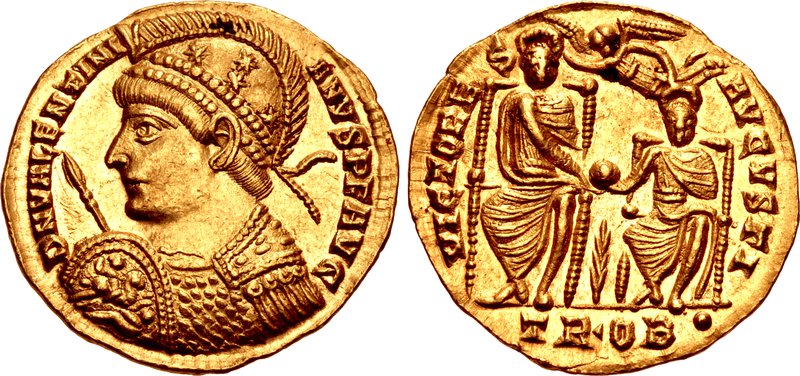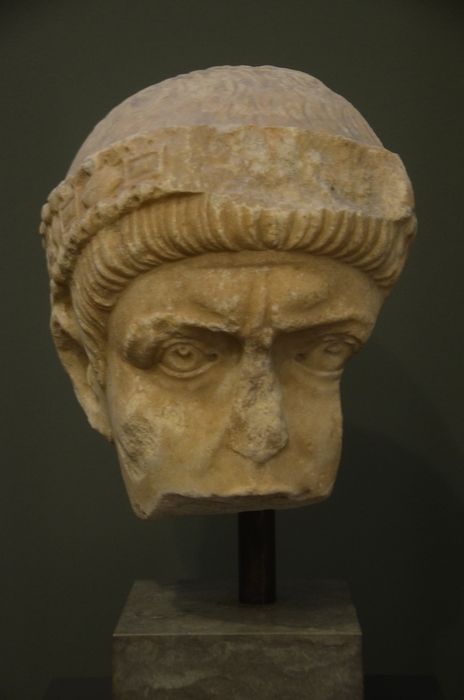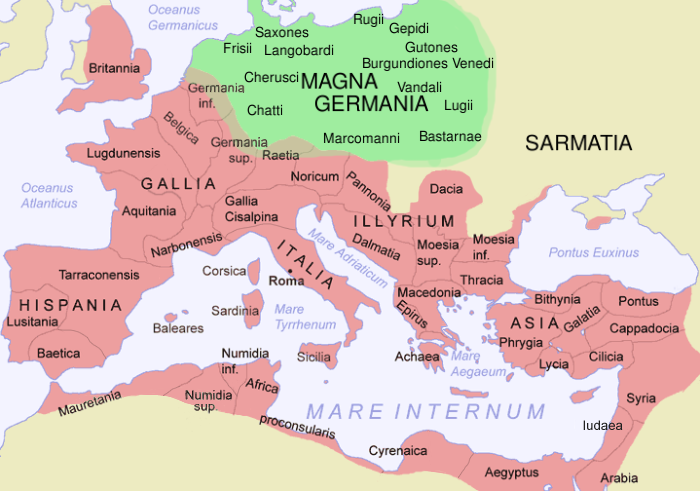|
Gratianus
Gratian (; la, Gratianus; 18 April 359 – 25 August 383) was emperor of the Western Roman Empire from 367 to 383. The eldest son of Valentinian I, Gratian accompanied his father on several campaigns along the Rhine and Danube frontiers and was raised to the rank of ''Augustus'' in 367. Upon the death of Valentinian in 375, Gratian took over government of the west while his half-brother Valentinian II was also acclaimed emperor in Pannonia. Gratian governed the western provinces of the empire, while his uncle Valens was already the emperor over the east. Gratian subsequently led a campaign across the Rhine, attacked the Lentienses, and forced the tribe to surrender. That same year, the eastern emperor Valens was killed fighting the Goths at the Battle of Adrianople, which led to Gratian elevating Theodosius to replace him in 379. Gratian favoured Nicene Christianity over traditional Roman religion, issuing the Edict of Thessalonica, refusing the office of '' pontifex maximus' ... [...More Info...] [...Related Items...] OR: [Wikipedia] [Google] [Baidu] |
Valentinian I
Valentinian I ( la, Valentinianus; 32117 November 375), sometimes called Valentinian the Great, was Roman emperor from 364 to 375. Upon becoming emperor, he made his brother Valens his co-emperor, giving him rule of the eastern provinces. Valentinian retained the west. During his reign, Valentinian fought successfully against the Alamanni, Quadi, and Sarmatians. Most notable was his victory over the Alamanni in 367 at the Battle of Solicinium. His general Count Theodosius defeated a revolt in Africa and the Great Conspiracy, a coordinated assault on Roman Britain by Picts, Scots, and Saxons. Valentinian was also the last emperor to conduct campaigns across both the Rhine and Danube rivers. Valentinian rebuilt and improved the fortifications along the frontiers, even building fortresses in enemy territory. He founded the Valentinianic dynasty, with his sons Gratian and Valentinian II succeeding him in the western half of the empire. Early life Valentinian was born in 321 ... [...More Info...] [...Related Items...] OR: [Wikipedia] [Google] [Baidu] |
Valens
Valens ( grc-gre, Ουάλης, Ouálēs; 328 – 9 August 378) was Roman emperor from 364 to 378. Following a largely unremarkable military career, he was named co-emperor by his elder brother Valentinian I, who gave him the eastern half of the Roman Empire to rule. In 378, Valens was defeated and killed at the Battle of Adrianople against the invading Goths, which astonished contemporaries and marked the beginning of barbarian encroachment into Roman territory. As emperor, Valens continually faced threats both internal and external. He defeated, after some dithering, the usurper Procopius in 366, and campaigned against the Goths across the Danube in 367 and 369. In the following years, Valens focused on the eastern frontier, where he faced the perennial threat of Persia, particularly in Armenia, as well as additional conflicts with the Saracens and Isaurians. Domestically, he inaugurated the Aqueduct of Valens in Constantinople, which was longer than all the aqueducts of R ... [...More Info...] [...Related Items...] OR: [Wikipedia] [Google] [Baidu] |
Valentinianic Dynasty
The Valentinianic or Valentinian dynasty was a ruling house of five generations of dynasts, including five Roman emperors during Late Antiquity, lasting nearly a hundred years from the mid fourth to the mid fifth century. They succeeded the Constantinian dynasty () and reigned over the Roman Empire from 364 to 392 and from 425 to 455, with an interregnum (392–423), during which the Theodosian dynasty ruled and eventually succeeded them. The Theodosians, who intermarried into the Valentinian house, ruled concurrently in the east after 379. The Valentinian dynasty's patriarch was Gratianus Funarius, whose sons Valentinian I and Valens were both made Roman emperors in 364. Valentinian I's two sons, Gratian and Valentinian II both became emperors. Valentinian I's daughter Galla (wife of Theodosius I), Galla married Theodosius the Great, the emperor of the eastern empire, who with his descendants formed the Theodosian dynasty (). In turn, their daughter, Galla Placida married a ... [...More Info...] [...Related Items...] OR: [Wikipedia] [Google] [Baidu] |
Theodosius I
Theodosius I ( grc-gre, Θεοδόσιος ; 11 January 347 – 17 January 395), also called Theodosius the Great, was Roman emperor from 379 to 395. During his reign, he succeeded in a crucial war against the Goths, as well as in two civil wars, and recognized the Catholic orthodoxy of Nicene Christians as the Roman Empire's state religion. Theodosius was the last emperor to rule the entire Roman Empire before its administration was permanently split between two separate courts (one western, the other eastern). Born in Hispania, Theodosius was the son of a high-ranking general, Theodosius the Elder, under whose guidance he rose through the ranks of the Roman Army. Theodosius held independent command in Moesia in 374, where he had some success against the invading Sarmatians. Not long afterwards, he was forced into retirement, and his father was executed under obscure circumstances. Theodosius soon regained his position following a series of intrigues and executions ... [...More Info...] [...Related Items...] OR: [Wikipedia] [Google] [Baidu] |
Magnus Maximus
Magnus Maximus (; cy, Macsen Wledig ; died 8 August 388) was Roman emperor of the Western Roman Empire from 383 to 388. He usurped the throne from emperor Gratian in 383 through negotiation with emperor Theodosius I. He was made emperor in Britannia and Gaul the next year while Gratian's brother Valentinian II retained Italy, Pannonia, Hispania, and Africa. In 387, Maximus's ambitions led him to invade Italy, resulting in his defeat by Theodosius I at the Battle of Poetovio in 388. In the view of some historians, his death marked the end of direct imperial presence in Northern Gaul and Britain. Life Birth, army career Maximus was born in Gallaecia, on the estates of Count Theodosius (the Elder) of the Theodosian dynasty, to whom he claimed to be related.J. B. Bury ed. (1924)''The Cambridge Medieval History'' p. 238 Maximus was a distinguished general; he was probably a junior officer in Britain in 368, during the quelling of the Great Conspiracy. He served under Count Theodos ... [...More Info...] [...Related Items...] OR: [Wikipedia] [Google] [Baidu] |
Bust (sculpture)
A bust is a sculpted or cast representation of the upper part of the human figure, depicting a person's head and neck, and a variable portion of the chest and shoulders. The piece is normally supported by a plinth. The bust is generally a portrait intended to record the appearance of an individual, but may sometimes represent a type. They may be of any medium used for sculpture, such as marble, bronze, terracotta, plaster, wax or wood. As a format that allows the most distinctive characteristics of an individual to be depicted with much less work, and therefore expense, and occupying far less space than a full-length statue, the bust has been since ancient times a popular style of life-size portrait sculpture. It can also be executed in weaker materials, such as terracotta. A sculpture that only includes the head, perhaps with the neck, is more strictly called a "head", but this distinction is not always observed. Display often involves an integral or separate display stan ... [...More Info...] [...Related Items...] OR: [Wikipedia] [Google] [Baidu] |
Nicene Christianity
The original Nicene Creed (; grc-gre, Σύμβολον τῆς Νικαίας; la, Symbolum Nicaenum) was first adopted at the First Council of Nicaea in 325. In 381, it was amended at the First Council of Constantinople. The amended form is also referred to as the Nicene Creed, or the Niceno-Constantinopolitan Creed for disambiguation. The Nicene Creed is the defining statement of belief of Nicene or mainstream Christianity and in those Christian denominations that adhere to it. The Nicene Creed is part of the profession of faith required of those undertaking important functions within the Orthodox and Catholic Churches. Nicene Christianity regards Jesus as divine and "begotten of the Father". Various non-Nicene doctrines, beliefs, and creeds have been formed since the fourth century, all of which are considered heresies by adherents of Nicene Christianity. In Western Christianity, the Nicene Creed is in use alongside the less widespread Apostles' Creed. In musical setting ... [...More Info...] [...Related Items...] OR: [Wikipedia] [Google] [Baidu] |
Flavia Maxima Constantia
Flavia Maxima Constantia (361/362 – 383) was the first empress consort of Gratian of the Western Roman Empire. According to Ammianus Marcellinus, Constantia was a posthumous child of Constantius II by his third wife Faustina. Her paternal grandparents were Constantine the Great and Fausta. Early life Constantia's paternal uncles included Crispus, Constantine II and Constans. Her paternal aunts included Constantina, wife of first Hannibalianus and secondly Constantius Gallus, and Helena, wife of Julian the Apostate. On 5 October 361, Constantius II died of a fever at Mopsucrene, near Tarsus, Cilicia. He was heading west to face a revolt by Julian, his first cousin and brother-in-law. In a reported deathbed decision, Constantius officially acknowledged Julian as his heir. When Constantia was born sometime after, Julian was already firmly established on the throne. On 26 June 363, Julian was fatally wounded in the Battle of Samarra against the forces of Shapur II of the Sass ... [...More Info...] [...Related Items...] OR: [Wikipedia] [Google] [Baidu] |
Laeta
Laeta was the second Empress consort of Gratian of the Western Roman Empire. Family The only relation of Laeta mentioned by Zosimus was her mother Pissamena.Zosimus, "''Historia Nova'', Book five, 1814 translation by Green and Chaplin Empress Gratian was first married to Flavia Maxima Constantia, who died at only twenty-one. The ''Chronicon Paschale'' dates the arrival of Constantia's remains in Constantinople to 31 August 383. She must have died earlier in the same year but the exact date and cause of her death are unknown. As Gratian was himself assassinated on 25 August 383, Laeta is assumed to have married him in the short period between the death of Constantia and his death. On his account of the first siege of Rome by Alaric I, King of the Visigoths (dated to 408), Zosimus mentions that the city faced a famine. Zosimus records that ''"Laeta the wife of the late emperor Gratian, and her mother Pissamena, supplied great numbers with food for some time. For since they were ... [...More Info...] [...Related Items...] OR: [Wikipedia] [Google] [Baidu] |
Marina Severa
Marina Severa (died before 375) was the Empress of Rome and first wife of Emperor Valentinian I. She was the mother of later Emperor Gratian. Her full name is unknown. Marina Severa is a combination of the two names given in primary sources. Socrates of Constantinople calls her "Severa" while John Malalas, the ''Chronicon Paschale'' and John of Nikiû name her "Marina". Life Marina Severa married Valentinian before he ascended to the throne. Their son, Gratian was born in 359 at Sirmium in Pannonia. Valentinian was chosen emperor in 364. He divorced his wife around 370 to marry Justina (empress), Justina, widow of usurper Magnentius. According to Socrates of Constantinople: This account was dismissed by later historians whose interpretation of it was an unlikely legalization of Bigamy#Bigamy, bigamy. However Timothy Barnes (classicist), Timothy Barnes and others consider this decision to only allow various Romans to divorce and then remarry. The controversy being that Christi ... [...More Info...] [...Related Items...] OR: [Wikipedia] [Google] [Baidu] |
Danube
The Danube ( ; ) is a river that was once a long-standing frontier of the Roman Empire and today connects 10 European countries, running through their territories or being a border. Originating in Germany, the Danube flows southeast for , passing through or bordering Austria, Slovakia, Hungary, Croatia, Serbia, Romania, Bulgaria, Moldova, and Ukraine before draining into the Black Sea. Its drainage basin extends into nine more countries. The largest cities on the river are Vienna, Budapest, Belgrade and Bratislava, all of which are the capitals of their respective countries; the Danube passes through four capital cities, more than any other river in the world. Five more capital cities lie in the Danube's basin: Bucharest, Sofia, Zagreb, Ljubljana and Sarajevo. The fourth-largest city in its basin is Munich, the capital of Bavaria, standing on the Isar River. The Danube is the second-longest river in Europe, after the Volga in Russia. It flows through much of Central and Sou ... [...More Info...] [...Related Items...] OR: [Wikipedia] [Google] [Baidu] |
Rhine
), Surselva, Graubünden, Switzerland , source1_coordinates= , source1_elevation = , source2 = Rein Posteriur/Hinterrhein , source2_location = Paradies Glacier, Graubünden, Switzerland , source2_coordinates= , source2_elevation = , source_confluence = Reichenau , source_confluence_location = Tamins, Graubünden, Switzerland , source_confluence_coordinates= , source_confluence_elevation = , mouth = North Sea , mouth_location = Netherlands , mouth_coordinates = , mouth_elevation = , progression = , river_system = , basin_size = , tributaries_left = , tributaries_right = , custom_label = , custom_data = , extra = The Rhine ; french: Rhin ; nl, Rijn ; wa, Rén ; li, Rien; rm, label= Sursilvan, Rein, rm, label= Sutsilvan and Surmiran, Ragn, rm, label=Rumantsch Grischun, Vallader and Puter, Rain; it, Reno ; gsw, Rhi(n), inclu ... [...More Info...] [...Related Items...] OR: [Wikipedia] [Google] [Baidu] |





_A_king%2C_possibly_Magnus_Maximus%2C_holding_a_sceptre.jpg)

